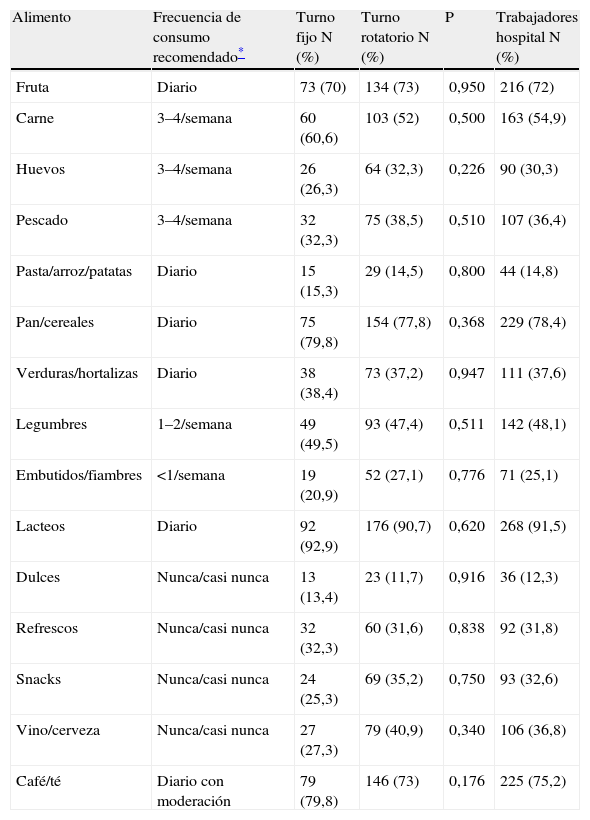Analizar los hábitos alimentarios y la actividad física de los trabajadores de un hospital dependiendo de la turnicidad.
MétodoEstudio descriptivo transversal de 311 trabajadores incluidos en nómina en enero del año 2007. Se realizó mediante un cuestionario en el que se incluyeron variables de la Encuesta Nacional de Salud, que incluía frecuencia de consumo de alimentos, IMC y actividad física.
ResultadosEl porcentaje de respuesta global fue del 35,5%. Participaron 140 enfermeras (47%), 67 auxiliares enfermería (22,5%) y 35 médicos (11,7%). Su edad media es de 39 años (DE=8), siendo la mayoría mujeres que viven con su pareja (69,25%) y sus hijos (64,8%), siendo uno el número de hijos.
No encontramos diferencias significativas al analizar ninguna de las 3 variables estudiadas (IMC, actividad física y consumo de alimentos) relacionándolas con la turnicidad.
El IMC es 23,17kg/m2 (DE=3,4), teniendo un 2,4% peso insuficiente, 74,6% normopeso, 19% sobrepeso y un 4% obesidad. El IMC de los trabajadores a turno rotatorio se asemeja al recomendado por la Sociedad Española para el Estudio de la Obesidad.
Se encontró una alimentación más saludable en el turno rotatorio respecto al turno fijo en el consumo de fruta, huevos, pescado, embutidos, snacks y alcohol. Un 72,9 % de los trabajadores realizan algún tipo de actividad física y un 27% son sedentarios.
ConclusionesEn este estudio la turnicidad no influye negativamente en el IMC, hábitos de alimentación y actividad física de los trabajadores del hospital.
To assess the eating habits and physical activity of hospital shift workers.
MethodA descriptive, cross-sectional study of 311 workers on the payroll in January 2007. It was conducted using a questionnaire using the variables of the National Health Questionnaire (Encuesta Nacional de Salud), which included food consumption, body mass index (BMI) and physical activity.
ResultsThe overall percentage response was 35.5%. A total of 140 nurses (47%), 67 auxiliary nurses (22.5%) and 35 medical staff (11.7%). Their mean age was 39 years (SD=8), with the majority being females who lived with their partner (69.25%) and their children (64.8%). The mean number of children was 1.
We did not find any significant differences on analysing any of the three variables studied (BMI, physical activity and food consumption) associated with shift-work.
The BMI was 23.17kg/m2 (SD=3.4), with 2.4% under-weight, 74.6% normal, 19% overweight and 4% obese. The BMI of shift workers is similar to that recommended by the Spanish Society for the Study of Obesity.
A more healthy diet is observed in shift workers compared to a fixed shift, with the consumption of fruit, eggs, fish, cold meats, snacks and alcohol. The majority of workers (72.9%) carried out some type of physical activity and 27% were sedentary.
ConclusionsIn this study, shift work did not negatively influence the BMI, eating habits or physical activity of the hospital workers.
Artículo
Comprando el artículo el PDF del mismo podrá ser descargado
Precio 19,34 €
Comprar ahora










